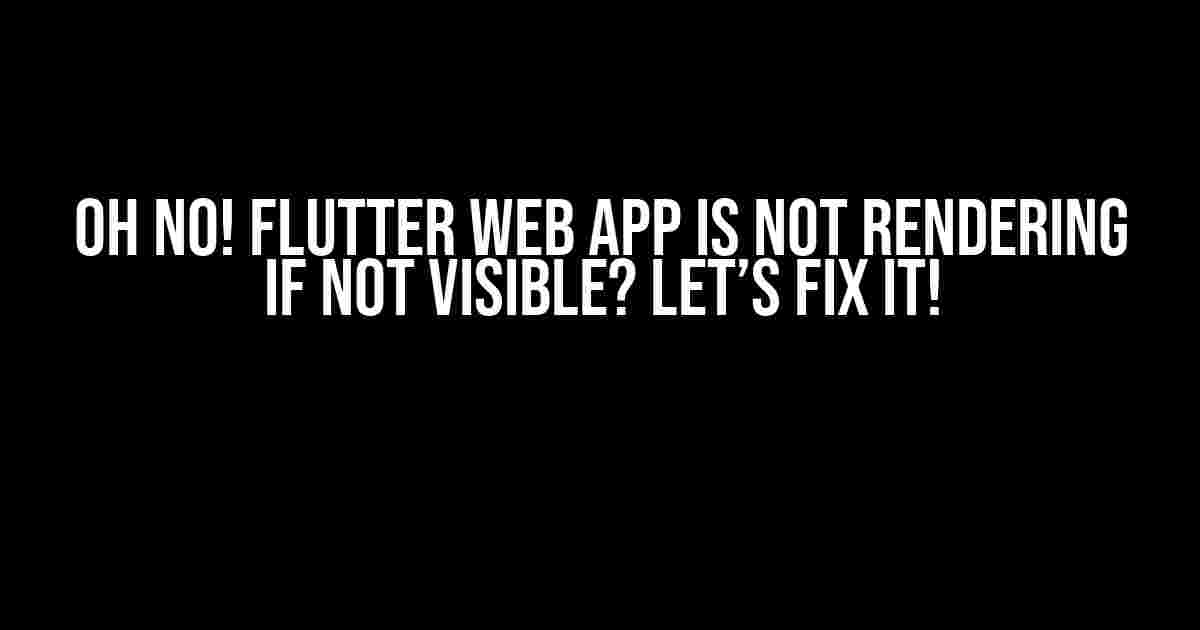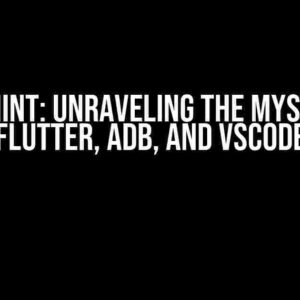Have you ever faced the frustrating issue where your Flutter web app refuses to render when it’s not visible? You’re not alone! This problem has been plaguing many developers, and today, we’re going to tackle it head-on. Buckle up, folks, as we dive into the world of Flutter web app rendering and explore the possible causes and solutions to this pesky problem.
What’s the Issue Again?
To recap, the problem we’re dealing with is that your Flutter web app doesn’t render when it’s not visible. This could be due to various reasons, such as:
- The app is rendered on a different tab or window.
- The app is minimized or hidden behind another window.
- The app is not focused or is in the background.
In any of these scenarios, your Flutter web app might not render as expected, leaving your users with a blank or incomplete page.
Why is This Happening?
Before we dive into the solutions, let’s understand why this issue occurs in the first place. There are several reasons that might contribute to this problem:
- Lack of focus**: When your app is not in focus or is hidden, the browser might not render the page until it’s visible again.
- Resource constraints**: The browser might be conserving resources by not rendering the page when it’s not visible, especially on mobile devices or low-end hardware.
- Flutter’s rendering mechanism**: Flutter uses a unique rendering mechanism that might not play nicely with the browser’s rendering pipeline, leading to rendering issues when the app is not visible.
Solution 1: Use the `window Visibility API`
One way to tackle this issue is by using the `window Visibility API`. This API allows you to detect when the page is visible or hidden, enabling you to take action accordingly.
<script>
let visibilityChange = () => {
if (document.visibilityState === 'visible') {
// The page is now visible, render the app
runApp();
} else {
// The page is hidden, pause the app
pauseApp();
}
};
document.addEventListener('visibilitychange', visibilityChange);
</script>
In the code above, we’re using the `visibilityChange` event listener to detect when the page’s visibility changes. When the page becomes visible, we call the `runApp()` function to render the app. Conversely, when the page is hidden, we call the `pauseApp()` function to pause the app.
Solution 2: Utilize `IntersectionObserver`
Another approach is to use the `IntersectionObserver` API, which allows you to detect when an element becomes visible or invisible within the viewport.
<script>
const observer = new IntersectionObserver((entries) => {
if (entries[0].isIntersecting) {
// The app is now visible, render the app
runApp();
} else {
// The app is hidden, pause the app
pauseApp();
}
}, { threshold: 1.0 });
observer.observe(document.getElementById('app-container'));
</script>
In this example, we create an `IntersectionObserver` instance and pass it a callback function that’s triggered when the observed element (in this case, the app container) becomes visible or invisible. When the app becomes visible, we call the `runApp()` function, and when it’s hidden, we call the `pauseApp()` function.
Solution 3: Leverage `MutationObserver`
Yet another approach is to use the `MutationObserver` API, which allows you to detect changes to the DOM, including changes to an element’s visibility.
<script>
const observer = new MutationObserver((mutations) => {
for (const mutation of mutations) {
if (mutation.type === 'attributes' && mutation.attributeName === 'hidden') {
if (mutation.target.hidden) {
// The app is now hidden, pause the app
pauseApp();
} else {
// The app is now visible, render the app
runApp();
}
}
}
});
observer.observe(document.getElementById('app-container'), {
attributes: true,
attributeFilter: ['hidden']
});
</script>
In this example, we create a `MutationObserver` instance and pass it a callback function that’s triggered when the observed element’s `hidden` attribute changes. When the app becomes hidden, we call the `pauseApp()` function, and when it becomes visible, we call the `runApp()` function.
Solution 4: Flutter-Specific Solutions
If the above solutions don’t work for you, there are some Flutter-specific solutions you can try:
- Use `WidgetsBinding.instance.addPostFrameCallback`**: This allows you to schedule a callback to run after the frame is built, ensuring that the app is rendered when it becomes visible.
- Override `WidgetsBinding.deferFirstFrame`**: By overriding this method, you can control when the first frame is rendered, allowing you to render the app when it becomes visible.
- Use `TickerProviderStateMixin`**: This mixin provides a way to schedule ticks on the widget tree, enabling you to control when the app is rendered.
Conclusion
There you have it, folks! Four solutions to help you overcome the pesky issue of your Flutter web app not rendering when it’s not visible. Whether you choose to use the `window Visibility API`, `IntersectionObserver`, `MutationObserver`, or Flutter-specific solutions, you should now have a working app that renders beautifully, even when it’s not visible.
| Solution | Description |
|---|---|
| Window Visibility API | |
| IntersectionObserver | |
| MutationObserver | |
| Flutter-Specific Solutions |
Remember, each solution has its own strengths and weaknesses, so be sure to choose the one that best fits your use case. Happy coding, and may your Flutter web app render beautifully, always!
Additional Resources
- Window Visibility API
- IntersectionObserver API
- MutationObserver API
- Flutter Widgets
- TickerProviderStateMixin
We hope this article has been helpful in solving the issue of your Flutter web app not rendering when it’s not visible. If you have any further questions or need additional guidance, please don’t hesitate to ask.
Here are 5 Questions and Answers about “Flutter Web App is not rendering if not visible” in a creative voice and tone:
Frequently Asked Questions
Get the answers to your burning questions about Flutter Web App not rendering when not visible!
Why is my Flutter Web App not rendering when it’s not visible?
This is a known issue in Flutter Web, where the app doesn’t render if it’s not visible on the screen. This is due to the way Flutter uses the browser’s rendering engine. Don’t worry, we’ve got some workarounds for you!
Is this a bug in Flutter or a feature?
While it may seem like a bug, this behavior is actually a feature of Flutter Web. It’s designed to improve performance by not rendering invisible elements. However, we know it can be frustrating, so we’ve got some tips to help you work around it!
How can I force my Flutter Web App to render even when not visible?
One way to force rendering is to use the `WidgetsBinding.instance.addPostFrameCallback` method. This will ensure that your app renders even when it’s not visible. There are other workarounds too, like using a `Visibility` widget or `OverflowBox`. We’ve got more details in our documentation!
Will this issue be fixed in future versions of Flutter?
The Flutter team is working hard to improve the performance and rendering of Flutter Web. While we can’t promise a specific timeline, we’re committed to making your life as a developer easier. Stay tuned for updates and keep an eye on our GitHub issues for the latest developments!
Where can I find more resources to help me with this issue?
We’ve got you covered! Check out our official Flutter documentation, the Flutter Slack channel, and Stack Overflow for more resources and answers from the community. You can also file a GitHub issue if you have a specific problem or suggestion. We’re here to help!






